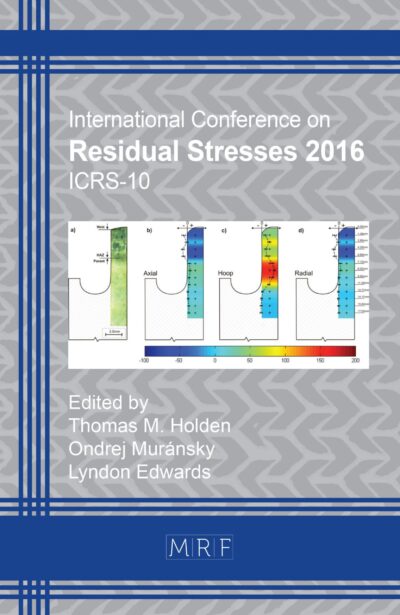Experimental investigation and analysis evaluations of the wear condition of AISI H13 material
Özgün Yurdakul, Aptullah Karakaş, Bülent Acar
Abstract. In metal forming processes, wear phenomenon on die parts plays a major role for many purposes like life estimation of the die usage and output workpiece surface quality. In general, tool steel AISI H13 is generally used for object since combination of wear resistance and strength with toughness. For that purpose, to observe the behavior of the wear property of the AISI H13 steel, micro scratch test that is rarely studied in the literature for wear purposes has been studied in this work for observation of the wear phenomenon in micro scale. Furthermore, finite element analysis has been done for this test to establishing a correlation between experimental results and simulations to obtaining possibility to observation varied scenarios based on altered parameters. In this purpose, Archard’s wear equation is based to observation of wear behavior. After experimental data has been obtained with micro scratch tests, wear behavior of output of the finite element analysis shows equivalence with experimental results.
Keywords
AISI H13 Steel, Micro Scratch Test, Archard’s Wear Equation, Finite Element Analysis
Published online 5/7/2025, 9 pages
Copyright © 2025 by the author(s)
Published under license by Materials Research Forum LLC., Millersville PA, USA
Citation: Özgün Yurdakul, Aptullah Karakaş, Bülent Acar, Experimental investigation and analysis evaluations of the wear condition of AISI H13 material, Materials Research Proceedings, Vol. 54, pp 1087-1095, 2025
DOI: https://doi.org/10.21741/9781644903599-118
The article was published as article 118 of the book Material Forming
![]() Content from this work may be used under the terms of the Creative Commons Attribution 3.0 license. Any further distribution of this work must maintain attribution to the author(s) and the title of the work, journal citation and DOI.
Content from this work may be used under the terms of the Creative Commons Attribution 3.0 license. Any further distribution of this work must maintain attribution to the author(s) and the title of the work, journal citation and DOI.
References
[1] B.-A. Behrens, A. Bouguecha, M. Vucetic, and A. Chugreev, “Advanced Wear Simulation for Bulk Metal Forming Processes,” MATEC Web Conf., vol. 80, p. 04003, 2016. https://doi.org/10.1051/matecconf/20168004003
[2] M. P. Pereira, W. Yan, and B. F. Rolfe, “Contact pressure evolution and its relation to wear in sheet metal forming,” Wear, vol. 265, no. 11–12, pp. 1687–1699, Nov. 2008. https://doi.org/10.1016/j.wear.2008.04.042
[3] Fuchs, K.-D. (2009). Hot-Work Tool Steels With Improved Properties For Die Casting Applications. 183.
[4] H. Yan, J. Hua, and R. Shivpuri, “Flow stress of AISI H13 die steel in hard machining,” Materials & Design, vol. 28, no. 1, pp. 272–277, Jan. 2007. https://doi.org/10.1016/j.matdes.2005.06.017
[5] M. X. Wei, S. Q. Wang, L. Wang, X. H. Cui, and K. M. Chen, “Effect of tempering conditions on wear resistance in various wear mechanisms of H13 steel,” Tribology International, vol. 44, no. 7–8, pp. 898–905, Jul. 2011. https://doi.org/10.1016/j.triboint.2011.03.005
[6] M. G. Gee and S. Owen-Jones, Wear Testing Methods and Their Relevance to Industrial Wear Problems. National Physical Laboratory, NPL Report CMMT(A) 92, 1999. [Online]. Available: https://eprintspublications.npl.co.uk/3426/1/cmmt92.pdf
[7] M. Hussein, A. Mohammed, and N. Al-Aqeeli, “Wear Characteristics of Metallic Biomaterials: A Review,” Materials, vol. 8, no 5, pp. 2749–2768, May 2015. https://doi.org/10.3390/ma8052749
[8] K. Berglund, M. Rodiouchkina, J. Hardell, K. Kalliorinne, and J. Johansson, “A Novel Reciprocating Tribometer for Friction and Wear Measurements with High Contact Pressure and Large Area Contact Configurations,” Lubricants, vol. 9, no. 12, p. 123, Dec. 2021. https://doi.org/10.3390/lubricants9120123
[9] P. Lu, X. Xiao, M. Lukitsch, and K. Chou, “Micro-Scratch Testing and Simulations for Adhesion Characterizations of Diamond-Coated Tools,” vol. 39, 2011.
[10] A. Vencl, N. Manić, V. Popovic, and M. Mrdak, “Possibility of the Abrasive Wear Resistance Determination with Scratch Tester,” Tribol Lett, vol. 37, no. 3, pp. 591–604, Mar. 2010. https://doi.org/10.1007/s11249-009-9556-x
[11] P. Chai, S. Li, Y. Li, and X. Yin, “Study on Damage of 4H-SiC Single Crystal through Indentation and Scratch Testing in Micro–Nano Scales,” Applied Sciences, vol. 10, no. 17, p. 5944, Aug. 2020. https://doi.org/10.3390/app10175944
[12] M. Hanief and M. S. Charoo, “Archard’s wear law revisited to measure accurate wear coefficient considering actual sliding velocity,” Materials Today: Proceedings, vol. 47, pp. 5598–5600, 2021. https://doi.org/10.1016/j.matpr.2021.03.475
[13] V. L. Popov and R. Pohrt, “Adhesive wear and particle emission: Numerical approach based on asperity-free formulation of Rabinowicz criterion,” Friction, vol. 6, no. 3, pp. 260–273, Sep. 2018. https://doi.org/10.1007/s40544-018-0236-4
[14] J. L. Bucaille, E. Felder, and G. Hochstetter, “Mechanical analysis of the scratch test on elastic and perfectly plastic materials with the three-dimensional finite element modeling,” Wear, vol. 249, no. 5–6, pp. 422–432, Jun. 2001. https://doi.org/10.1016/S0043-1648(01)00538-5
[15] S. Madge, “Toughness of Bulk Metallic Glasses,” Metals, vol. 5, no. 3, pp. 1279–1305, Jul. 2015. https://doi.org/10.3390/met5031279
[16] E. Guenther, M. Kahlert, M. Vollmer, T. Niendorf, and C. Greiner, “Tribological Performance of Additively Manufactured AISI H13 Steel in Different Surface Conditions,” Materials, vol. 14, no. 4, p. 928, Feb. 2021. https://doi.org/10.3390/ma14040928














